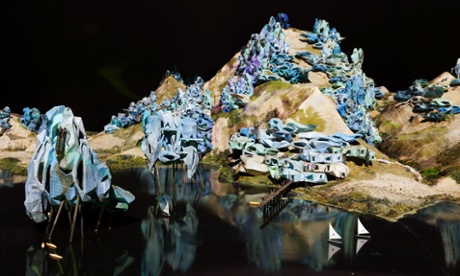‘You wouldn’t be able to get away with this in England,” says Amanda Levete, walking up the steep stone roof of her new building, which projects out over the sparkling waters of the Tagus like the prow of a ship. “Thankfully, Lisbon has a more liberal attitude to gradient.”
The British architect’s serpentine structure, rearing up from the riverside in a sinuous swoosh, is the €20m (£17.6m) home of the Museum of Art, Architecture and Technology (MAAT). It has been created and funded by the EDP Foundation, the non-profit arm of Portugal’s largest energy company, on a site next to the former Central Tejo power station in Belém, a handsome redbrick and steel temple of electricity that has also been transformed, its industrial halls reborn with white-cube galleries.
“Lisbon is undergoing a tourism boom,” says EDP boss António Mexia, referring to the 6 million visitors who pound the city’s pavements each year, in search of custard tarts. “This will be the hotspot of the hotspots.” Mexia clearly wanted an edifice that shouted “hotspot”: Levete’s scaly creature looks like something that might have slithered up from the depths of the river, its faceted crackle-glazed tiles giving the appearance of exotic snakeskin.
The tiles were still being frantically screwed into place on the opening day this week, but the fact the project has gone ahead at all, given the country’s recent turmoil, is something of a miracle. It is partly explained by EDP’s powerful backing: Chinese energy company China Three Gorges now holds the biggest stake in the company, following Portugal’s 2011 fire-sale of state assets. Its €2.7bn of investment means that, while the publicly funded National Coach Museum by Paulo Mendes da Rocha across the street languished unopened for two years and still awaits its crucial footbridge, MAAT has had a relatively smooth ride, and will likely sprout its own bridge before its neighbour.
Such links are crucial to stitching Lisbon’s riverfront back to the city. Having long turned its back on the tangled knot of wharves and docks, the city has been attempting to embrace its river over the last decade, with a new bike path and piecemeal public spaces emerging along the banks of the Tagus, although the critical obstacles of a railway line and two roads still remain.
By lifting people up, Levete aims to create a visual as well as physical connection across this gulf. When the new footbridge is installed in March, visitors will be brought straight across to the roof, on to a hump-backed piazza that provides an elevated vantage point both back to the city and out across the river, where the museum plans to host film screenings. It would be a skateboarder’s paradise, complete with low slaloming rails – but, despite the rhetoric of experimental performative participation, the foundation has banned skaters.
“The challenge here is to produce something totally different from other museums,” says museum director Pedro Gadanho, as he bobs up and down on an exercise ball beneath a mesh canopy in MAAT’s oval exhibition space. “The work will all be site-specific. It will be a place where artists and architects are exhibited together on the same intellectual level.” A forthcoming show will feature Superstudio and Archigram alongside Wolfgang Tillmans and Hito Steyerl.
The space is currently strewn with oversized carpet sample books and more gym balls. Part prison, part playground, it is the work of French artist Dominique Gonzalez-Foerster, who filled Tate Modern’s turbine hall with a post-apocalyptic scene of bunk beds in 2008, and has now brought a dark narrative to Lisbon. “It’s what it might be like if extraterrestrials were to build a cage for humans,” she says, as the door slides shut, trapping us inside for the next 10 minutes.
Her description might apply to the museum itself. One local architect describes it as “an aquarium without the fish” and it’s a shrewd observation. Entering beneath the deep overhanging entrance, visitors are led down a ramp that loops around the central elliptical exhibition space and into a series of four subterranean rooms, with glossy white floors and curving white walls. They feel a bit like spaces awaiting their fit-out, specifically shaped for reasons that have yet to become apparent. For the opening weeks they are hosting changing video art and sound installations, but the echoing white rooms make the projections feel a little like placeholders.
“The museum wanted a counterpoint to the more conventional white cube galleries in the power station,” says Levete. The sense of vagueness might be explained by the fact that the foundation, which began plans for the museum years before appointing a director, didn’t really know what it wanted. There was no specific brief for what kind of rooms it needed, and the result feels a little incidental, with corridor-like spaces reminiscent of Zaha Hadid’s Maxxi museum in Rome. You feel like you’re on the way to the main event that never arrives.
The architects say the building was shaped to capture direct light in winter and provide a shaded terrace in summer, yet only one of the rooms actually enjoys natural light, through a small glazed slash in the ceiling. The relationship with the power station also feels clumsy, meeting the building with an awkward switchback ramp and making a circuitous route to get between the two. The tiles, meanwhile, have been badly bodged, cut by hand on site rather than water-jet cut to a template as specified, leaving edges that look like broken teeth. The architects insist it will be fixed, but it’s odd for it to go so wrong in the country that arguably has the greatest tradition of tile-laying. One can only hope that Levete’s £41m V&A expansion, currently under construction and featuring the world’s first porcelain-tiled courtyard, will have a happier outcome.
Gadanho admits that it will take at least a year to understand how to best use the spaces, but it’s hard not to think that the EDP Foundation’s plan was misjudged. Before MAAT, the site was home to an interesting jumble of old warehouses, which could have been adapted and extended to make a series of evocative galleries – in the manner of OMA’s Fondazione Prada in Milan – but the lust for an icon was too strong. It might be telling that, while Tate Modern transformed its oil tanks into an atmospheric venue for experimental art, EDP plans to convert its big cylindrical gas tank into a restaurant designed by Philippe Starck. It wants a hotspot after all.











